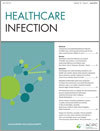
Healthcare Infection
Volume 19 Number 2 2014
HI14002Central line-associated bloodstream infection (CLABSI) rates: achieving the elusive goal of zero
Zero-risk for CLABSI is achievable – but not without applying distinctively different strategies. Currently, the majority of ICU patients have a short dwell time, <9 days, and with aseptic insertion will remain infection-free for their entire ICU stay. But the minority of patients have a longer dwell time, contribute the majority of CLABSI and require more than aseptic insertion to reduce the risk of infection. Consequently, aggregating short and longer dwell times prevents us from evaluating care.
HI13041Mandatory seasonal influenza vaccination of health care workers: a way forward to improving influenza vaccination rates
Annual influenza vaccination of healthcare workers is critical in preventing healthcare-associated transmission of influenza. The uptake of influenza vaccination by healthcare workers, however, remains poor despite availability of safe effective vaccines and annual, highly visible, voluntary strategies. New ideas including mandatory vaccination have now been employed successfully overseas to achieve sustained high rates of vaccination uptake. We discuss these strategies and ways to implement them.
HI13041 Abstract | HI13041 Full Text | HI13041PDF (82 KB) Open Access Article
HI13027Knowledge and understanding of patients and health care workers about multi-resistant organisms
This study explored the knowledge and understanding of patients and health care workers (HCWs) about multi-resistant organisms (MROs). The patients interviewed had a limited knowledge and understanding of MROs. Knowledge was generally inadequate among HCWs, and this was compounded by the majority of HCWs reporting that explaining a patient’s MRO status is beyond the scope of their knowledge. Policies and educational resources for infection control and prevention should give consideration to confidence-building and clear delineation of responsibility for informing patients of their MRO status.
HI13030Repeated multimodal supervision programs to reduce the central line-associated bloodstream infection rates in an Indian corporate hospital
Central line-associated bloodstream infections (CLABSI) are associated with significant morbidity, mortality and costs. The present study highlighted the role of repeated multimodal intervention programs in keeping the CLABSI rates low. This was evidenced by the overall 86.3% reduction in CLABSI rates in the entire study period showing a sustained decline after two intervention programs (first intervention:15.3%; second intervention: 36.9%; and post intervention:74.9%).
HI13034ATP bioluminescence to validate the decontamination process of gastrointestinal endoscopes
Gastrointestinal endoscopes become heavily contaminated and need careful and validated reprocessing. We evaluated ATP bioluminescence (relative light units) in 120 endoscopes to validate the decontamination processing. We conclude that ATP bioluminescence has the potential to play an important role. This process allows a quick testing turnaround time and for the endoscope to be classified as safe.
HI13034 Abstract | HI13034 Full Text | HI13034PDF (247 KB) Open Access Article
HI13044Nurses’ sharps, including needlestick, injuries in public and private healthcare facilities in New South Wales, Australia
Sharps-related injuries continue to be a significant hazard for healthcare workers. This paper examines data from two state-wide studies of nurses working in public and private healthcare facilities in New South Wales. It provides evidence of significant differences in sharps related injuries between these two sectors including what are the higher risk areas of practice, issues relating to reporting of incidents, perceptions of risk, recapping and safety-engineered medical devices.
HI13048Impact of a linerless, reusable, clinical wastebin system on costs, waste volumes and infection risk in an Australian acute-care hospital
Clinical waste is costly, is a potential infection risk to patients, staff and handlers, and needs careful management. This study found that a new reusable containment system enabled marked reductions in cost, risk, labour and volumes and received high praise in staff evaluations. The system enables reduced public healthcare spending, less environmental impact, greater safety and regulatory compliance.

